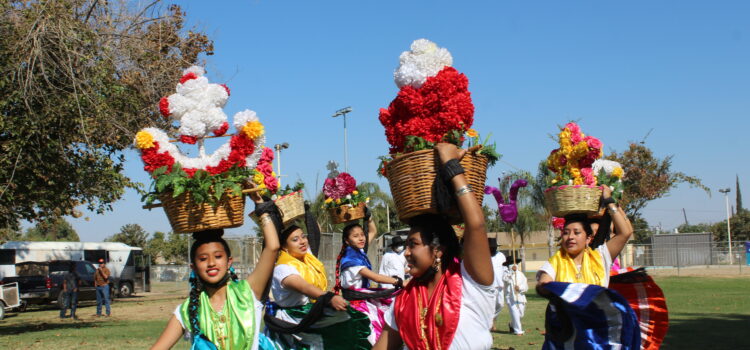
Article written by Alfonso J Sierra, Assosciate Editor at El Popular. Original story in Spanish translation can be found on El Popular’s website.
LAMONT, CA – Festive colors of blue, yellow, red and green decorated the various product booths featured last Sunday, October 10, at Lamont Park where a guelaguetza was held, bringing together several hundred people and street vendors and service organizations.
The event was sponsored by Unidad Benito Juárez, Patria, Progreso y Libertad who launched this event 20 years ago as a cultural event called “Festival Oaxaqueño”, which has evolved year after year until in 2006 it became the guelaguetza it is today, giving celebration and commemoration to the Oaxacan culture and its eight regions: Cañada, Coast, Isthmus, Mixteca, Papaloapan, Sierra Norte, Sierra Sur and Valles Centrales.
During the presentation, rich delicacies were discovered such as the pan de muerto, made in the district of Tlaxiaco (from Nahuatl: in the grove of the ball game; in Mixtec: Ndijiñu or Ndiñu: Buenavista), which is located in the Mixtec region. Among the Oaxacan gastronomy present was the Clayuda or Tlayuda, which consists of a large, thin tortilla that is toasted to crisp covered with refried beans, asiento, cabbage, avocado, tasajo, chorizo, and salsa to taste, which was really a hit with the people present.
The sweet bread made its presentation with the famous borrachos, which are red sponge bread, coconut and lechilla empanadas, gaznates and wafers filled with lechilla, brilliant representatives of the richness of the Oaxacan bakery that enjoy a solid tradition and stand out in their originality, and still carry the memory of the old times.
There is no great event without music and dance, that is why this celebration was honored to have among its acts the “Revelados del Dragon” from San Diego, California, who showed their skills with the whip and on stage with the dance of the Diablos, also called Judas, which is of Afro-Mexican origin, who danced to the Black God Ruja, whom they honored and asked for help to free themselves from their hard work situations. They dance in the center of town and in the surrounding neighborhoods creating disorder, but in reality they fight for good against evil. The dance dramatizes the incestuous battle between the forces of good, represented by the archangel St. Michael, and those of evil, personified by the devil foreman and his demonic forces.
The message of this dance is to help ourselves to connect with ourselves, to awaken emotions and fantasies through movement, which facilitates the expression of sensations, emotions, feelings and moods in a natural and uninhibited way.
The Chinas Oaxaqueñas come from the Coastal Region where they dance with beautiful dresses, the billowing skirts that illustrate the beautiful seas of the region, and where they have always been the hosts of the Oaxacan Guelaguetza and who dance the sones, jarabes and chilenas, standing out in the sones, when executed with a profane, joyful and typically mestizo music.
At the same time, during the event, a COVID-19 vaccination clinic was held by Adventist Health Delano, which administered the Johnson & Johnson, Pfizer and Moderna vaccines to anyone who wished to be vaccinated. Among the patients who obtained their vaccine were Francisco Contreras and Jose de Jesus Gurrola Jimenez, who were administered their third vaccine.
People who wished to receive flu shots, have their cholesterol measured, and other medical check-ups were able to do so through Dignity Health, who were on hand to administer these tests at no cost.
Sponsors of the event promoted the COVID-19 vaccination with banners and flags that were placed in locations around the Guelaguetza and the park.
“We scheduled the event the second week of October as a sign that we have a resilient community that still maintains its language, traditions, culture, art and folklore” commented Hector Hernandez, Executive Director of Unidad Popular Benito Juarez.